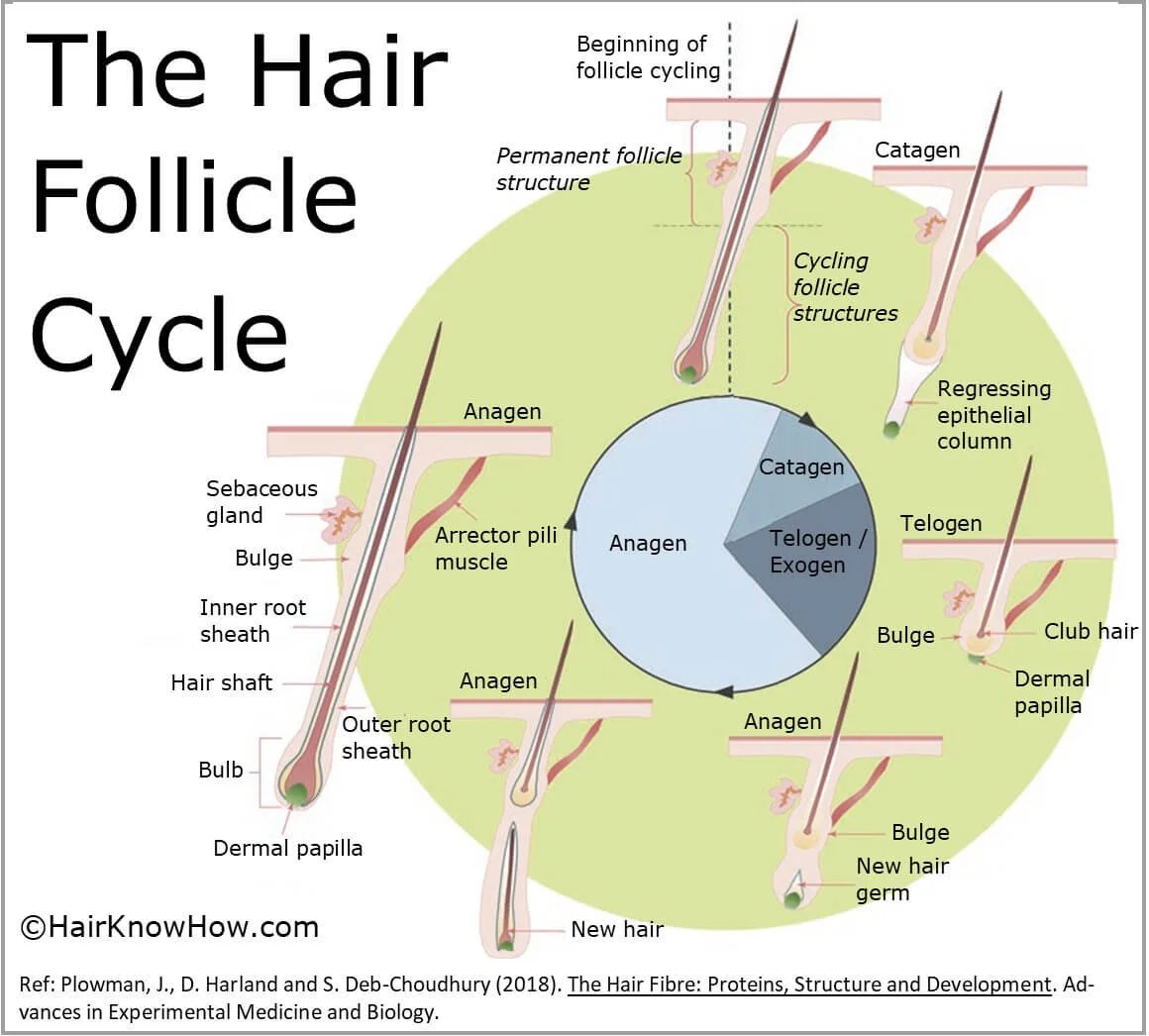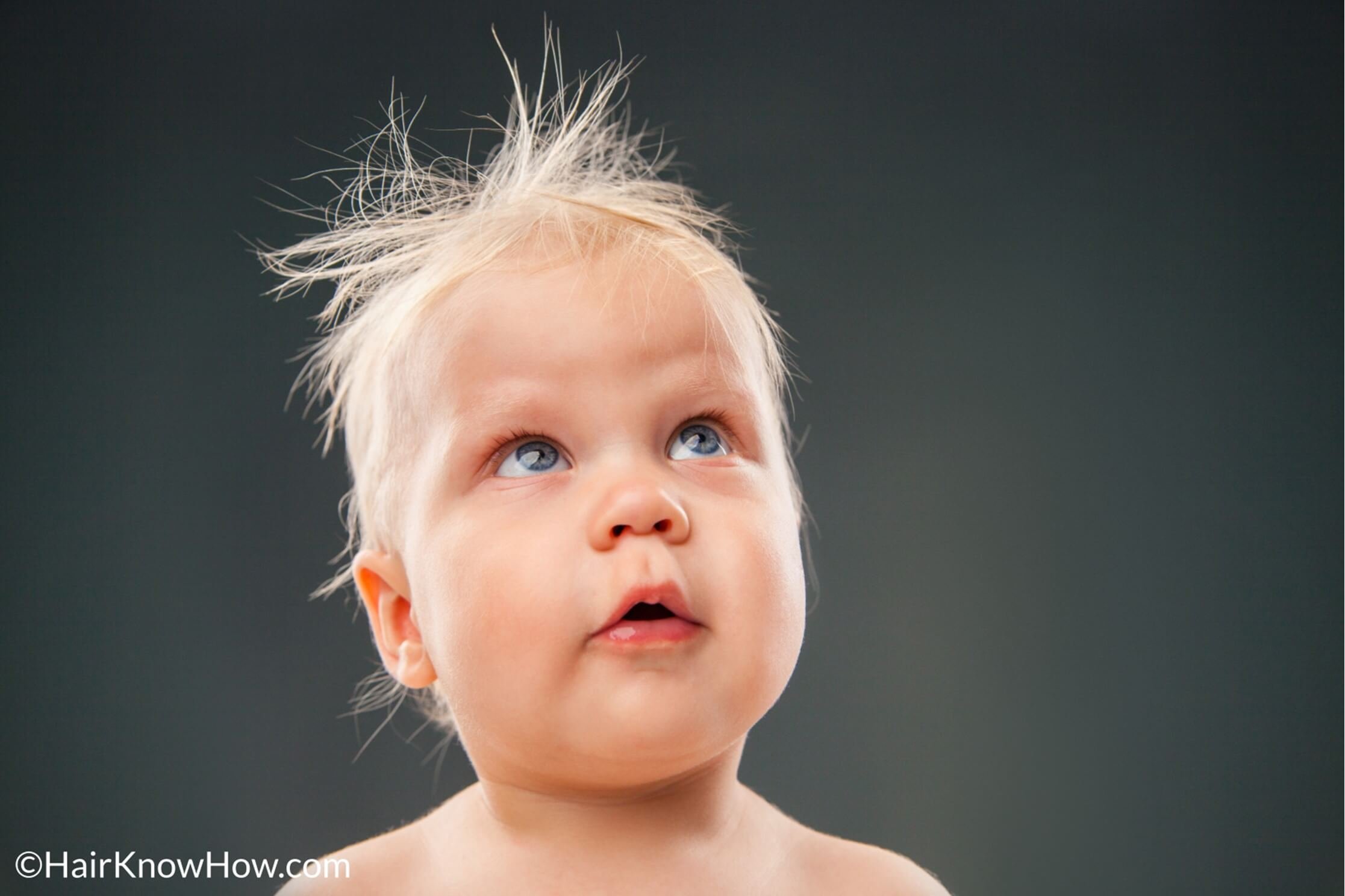Introduction to the follicle hair cycle
Our hair grows and matures, with older hair fibres eventually falling out. Hair fibres are rooted in an organ called the follicle, located within our skin. Lost or shed hair fibres are continually replaced by a new hair fibre that grows out of the follicle. The follicle is the only part of the hair that is considered alive and is the skin organ that is responsible for synthesising our hair.
This hair growth and loss process are not random, with hair falling out at random and unknowable intervals. The growth and shedding of our hair fibres is a highly regulated and complex biological process known as the hair follicle cycle and takes place within the follicle.
The follicle cycle can last as long as 13 years and consists of four main phases: anagen, catagen, telogen and exogen. Exogen is the phase in which hair shedding occurs. The exogen phase is incorporated or embedded within the telogen phase and is considered by some scientists to be its own discrete phase. These different phases of the follicle cycle are discussed in more detail below.
Errors within the different phases can result in changes in the density, total length, colour and health of our hair. These effects may be local, resulting in patches of hair changing, or changes may occur across the entire scalp.
Fun Fact: The maximum possible length of our hair is mainly governed by the length of time the hair follicle remains within the Anagen phase of the follicle cycle. The amount of time our follicles spend in anagen varies due to our environment and genetics – thanks, mum and dad!
A more detailed look at the hair follicle cycle
Within the follicle cycle, there are four main phases, anagen, catagen, telogen and exogen. Exogen, 'the fibre shedding stage', is its own distinct phase but appears to be embedded within telogen.
The Anagen Phase
During anagen, stem cells activate, and the base of the follicle develops, resulting in the growth of a new hair fibre from the follicle. The anagen phase is referred to as the "active growth phase" of a fibre and can last between 2-10 years. Anagen can be subdivided into six sub-phases (anagen I-VI), each possessing differing physiological and biochemical changes in the follicle. Some significant changes are detailed below.
In anagen I, hair germs cells (epidermal cells) thicken and undergoes prolongation between the dermal papilla and the club hair.
During anagen II, proliferating keratinocytes of the developing hair matrix partly enclose the swelling dermal papilla.
Anagen III is characterised by the formation of the Inner Root Sheath (called the IRS for short) – which is cone-shaped and the first sign of the new fibre. During anagen III, the follicle's base continues to grow deep into the skin. The hair shaft then becomes visible, surrounded by all three layers of the IRS (Henle's layer, Huxley's layer and the cuticle layer), which now extends up to the middle of the follicle. At the end of anagen III, the bulb and dermal papilla complete their growth downwards within the subcutis of the scalp.
The growing hair shaft occurs during anagen IV to VI; with anagen IV, the early fibre and IRS reach just below the sebaceous gland. The fibre enters the hair canal in anagen V and reaches the skin's surface in anagen VI.
The Catagen Phase
During catagen, the hair fibre stops growing and forms' club hair'. Club hair is essentially the end of the fibre, and its formation marks its termination whilst it is still within the follicle, making it ready to shed. Club hair forms during the transitional catagen phase that lasts only a short time of about three weeks.
Catagen starts with the removal of the papilla fibroblast intrusions from the basement membrane. These separate the dermal papilla cells from the stem cells in the bulb that make or synthesise the hair fibre and Inner Root Sheath (called the IRS for short). The dermal papilla and bulb then start to shrink. Club hair then forms, characterised by developing a brush-like hair base, including three layers of the emerging secondary hair germ capsule (ORS). Throughout catagen, the lower part of the follicle shrinks and withdraws the epithelial strand from around the panniculus carnosus; this leaves behind a round-shaped dermal papilla within the subcutis. Apoptosis (programmed cell death) begins within the epithelial strand of the keratinocytes. Epithelial cells within the follicle cease synthesising the proteins trichohyalin, transglutaminase I and desmoglein. Following catagen, the club hair base and germ capsule have relocated back into the dermis, with the dermal papilla moving back to the boundary between the dermis and cutis.
The Telogen Phase
Telogen is often thought of as the resting or sleeping phase of the follicle. However, substantial changes continue to occur within the follicle in preparation for synthesising the new fibre within the next follicle cycle. Within the telogen phase is exogen. During exogen, the previously produced anagen fibre now containing the club hair detaches. This duel of double phase lasts approximately three months.
During telogen, the follicle is at its smallest, comprising a small compact collection of dermal fibroblasts (shrunken dermal papilla) inactive immediately below the bulge that contains several epithelial stem cells. These structures mark the lower margin of the permanent part of the follicle. The papilla is extracellular, matrix poor, and its fibroblasts have minimal cytoplasm; nevertheless, they resemble the anagen follicle. The epithelial cells in the lower region of the follicle show little or no polymerase activity. This includes a notable absence of anagen phase proteins like trichohyalin and trichocyte. These epithelial cells synthesise the keratin K14, which holds the telogen hair fibre in place. Within the epithelial sac is the club hair or (aka the telogen shaft), a dead, fully keratinised hair with a brush-like base attached to the two-layered epidermal outer root sheath sac. The stem cells and the dermal papilla cells then trigger the end of telogen.
At the end of the telogen-exogen phase, the follicle enters the next anagen phase, and a new hair fibre is produced, starting the cycle again.
The Exogen Phase
The Exogen phase is a relatively newly discovered phase revealed by Milner's research carried out in 2002. This detachment phase is now known to be an active process resulting in distinct changes within the follicle and relatively weak fibre anchoring and its subsequent detachment.
The result of a functional hair follicle
Hair is constantly shedding at low levels all over our scalp in random locations. This hair loss, under normal circumstances, ensures that there are no visible patches, with the loss rate typically being low enough to safeguard against hair thinning, at least in theory.
Natural hair shedding and loss with severe hair breakage
In some cases of severe hair damage, increasing breakage can appear to increase the apparent natural loss of hair experienced daily. Fibre snapping adds to the amount of hair collected from your pillow in the morning, during a shower, brushing, etc. This perceived increase in hair loss can cause some anxiety in people. Still, in many cases, this increased hair breakage can be treated by first analysing the hair fibres to determine the type of damage sustained and then the causes of the damage can be addressed. For this, we recommend our porosity test or the complete hair health analysis.
Typical natural hair loss back-of-the-envelope calculations!
We will go over some numbers to calculate the typical rate of daily hair loss. Hopefully, this will make sense!
First, we need to determine what proportion of our hair was in each phase. Scientists have carefully counted (from many people's scalps) and discovered that, on average, approximately 1% of our follicles are in the catagen phase, 6-10% are in the telogen-exogen phase, with the remaining approximate 90-95% of hair follicles residing within the anagen fibre growth phase.
In addition, humans have approximately 150 to 200 follicles per cm2 on their scalps, equating to about 110,000 in total.
We start by calculating the number of follicles within the telogen-exogen phase (6-10%) at any one time from the 110,000 follicles present in total.
That’s 110,000 X 0.06 =6,600 (for the lower estimate and 110,000 X 0.1 = 11,000 for the upper limit representing the number of follicles present in the telogen-exogen phase at any one time.
Now, this doesn't mean that we lose up to 11,000 hair fibres at any time. That doesn't happen. In reality, we lose a relatively small number each day. This is because of two main reasons:
1). The chance of fibre detachment is mainly spread throughout the telogen-exogen phase
2). Each follicle is independent of each other from a hair follicle cycle perspective, so as some follicles are entering telogen-exogen, others will be exiting
In the final calculation, we calculate the amount of hair fibre shed daily. If we take the number of hair fibres within telogen-exogen and divide this by the average phase duration (about 90 days). 6,600 / 90 and 11,000 / 90 results in an approximate calculated (back of the envelope) shedding, loss, or drop rate of between 73 and 122 per day.
The scientific literature reports that between 50 -150 hair fibres per day are shed on average, so our calculated estimate is about right.
Isn't maths great! One hundred fifty fibres may sound a lot but remember, you have approximately 110,000 follicles on your scalp, so as a proportion, it's not many. For some context, it works out that most people lose about 0.13% of their hair at the maximum per day, which is not a lot.
For examples of what typical rates of natural hair loss look like please refer to our dedicated hair guide on natural hair shedding.
Why do humans shed hair?
The reason we shed our hair is related to our mammal ancestry, our evolution, and our mammal heritage. Wild mammals that live in higher-temperature climates tend to shed hair during the warmer months and regrow their hair in readiness for the colder months.
That way, the mammal concerned has a cleaner and healthy winter coat that enhances their chances of surviving the cold. This observation would have certainly been the case for the early mammals from which all modern mammals, including humans, descend, which could be a legacy of our evolutionary past.
For hundreds of thousands of years, humans have been less subject to changes in temperature due to our advent of fire and clothing. This type of technology would have lessened the need for any seasonal variation in our body's hair production, resulting in a disconnect been the temperature or season of the environment with a seasonal human hair follicle cycle. Hence our hair drops or is shed throughout the year.
Today, human hair signals the social status of its wearers, including their health, gender and the community they belong. These signals are communicated by how an individual's style, colour, length and even their hair's smell. Hair shedding and cutting is an integral part of the nonverbal communication of its owner.
When does hair first grow?
Hair first develops on the body during the embryological stage of life when a baby is in the womb or after birth (post-partum). Many babies possess lanugo hair at birth, with some being born with hair already established on their heads!
Fact: Babies are born with all the hair follicles they will ever have.
Get Expert Hair Analysis and Help
If you are worried about the health of your hair, or you want advice on what would be the best hair care solutions for your hair, please get in touch with HairKnowHow and give a HairKnowHow Hair Analysis a try!
Contact the HairKnowHow Team if you have any questions.






